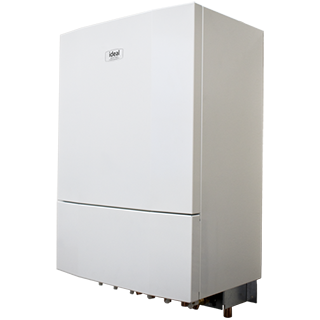Heat networks – also referred to as district or communal heating – are a flexible, tried and tested technology that has been safely and effectively heating homes and buildings and generating instantaneous hot water around the world for more than a century. In the UK, heat networks never really took hold as they have in other parts of Northern Europe as we discovered gas in the North Sea and instead placed reliance on natural gas delivered direct to individual homes from the 1960s onwards.
But that’s all set to change. Charlie Mowbray, Senior Product Manager, Ideal Heating – Commercial discusses how a transformation of heat generation technology and products in the UK is necessary if we are to reach Net Zero in 2050, and no single type of technology will provide the solution.
How will Heat Networks help achieve Net Zero?
Heat pumps are seen as one of the major technology types to realise our Net Zero ambitions, along with heat networks that are expected to provide up to 20% of heat in buildings by 2050. And, of course, discussions continue around Hydrogen fuelled appliances.
What are the components of a Heat Network?
There are three core parts to a heat network: the energy centre, the distribution network, and the heat interface unit (HIU).
The energy centre is the central plant room or dedicated building housing all the equipment responsible for generating or collecting the thermal energy, for storing it or transferring it to the water in the network, and pumping that water around the heat network.
As you would expect, the distribution network consists of all the pipework and any valves or ancillary equipment that distributes and balances the flow across the network. This might be buried in the ground or run up through risers in a building.
At the point of use within the dwelling is the heat interface unit (HIU). This is the appliance that transfers the thermal energy from the network to provide heating and hot water for the end user.
What are the benefits of a Heat Network?
Heat networks will gladly take their heat input from different sources, making them both flexible and future proof, allowing for gas boilers now but able to readily swap to lower carbon alternatives, such as heat pumps, in the future. With the current government indecision around the future of heating in the UK, this has to be a major benefit!
Heat networks are also a highly scalable solution, regardless of the area covered by the network, or the number of buildings. Furthermore, a single network can encompass dwellings and commercial buildings. Unlike other types of heating, heat networks can be relatively easily retrofitted into existing housing stock where traditional heating appliances are being replaced, particularly in high density housing, as the fabric of a building or the heating system in the dwelling may not necessarily have to be substantially altered to create the network. Safety is also another tick in the box for heat networks as there are no flue routes or gas connections to accommodate within a building, for either individual heating appliances or plant.
All these benefits, plus the end-user can receive the same level of comfort and service as they would expect from a traditional heating appliance. In the case of our POD HIUs, they even look like a domestic combi boiler from the outside with similar controls, so are familiar and reassuring to use.
HIU: Some Key considerations
Whilst the energy centre and distribution network represent the biggest capital costs of a heat network and are the most complex to get right, without the HIU the heat cannot be transferred to each dwelling/building. And in terms of the operating costs and efficiency of the network the HIU plays a vital role, but frequently gets less attention than deserved, sometimes resulting in the specification of a unit that’s not optimised for a particular scheme or application. To ensure that both the network and the HIUs are operating in harmony, and the heat network is working at its optimum, there are aspects that a specifier or installer should consider when choosing an HIU.
Heat Networks and Heat Interface Units are tried and tested technology, and a proven way in which we can help to decarbonise heat in buildings at scale. Ensuring that we realise the best efficiency on the networks, and provide great levels of service and thermal comfort for the resident, requires due diligence, common sense and attention to detail both in the design and installation phases, and high quality appliances.
Read the full Industry Spotlight article here: Ideal Heating Commercial Industry Spotlight Heat Networks Dos And Donts
This Industry Spotlight - Achieving an efficient and future proofed Heat Network – is just one of the ways you are able to stay up to date on the major subjects and topics driving the commercial heating industry. We are continually developing new resources to assist you on your own net zero journey, including case studies, white papers and instructive guides, visit our Net Zero page to view more articles - Join the Net Zero Journey.


